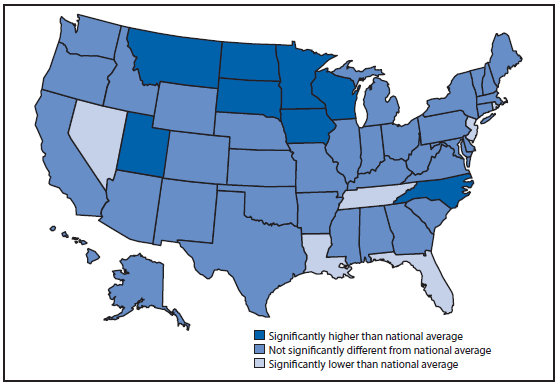QuickStats: Percentage of Office-Based Physicians with a Basic Electronic Health Record (EHR) System,* by State — National Electronic Health Records Survey,† United States, 2014§

* A basic EHR system is a system that has all of the following functionalities: patient history and demographics, patient problem lists, physician clinical notes, comprehensive list of patients' medications and allergies, computerized orders for prescriptions, and ability to view laboratory and imaging results electronically.
† A sample survey of office-based physicians.
§ All differences have been tested and determined to be statistically significant, unless otherwise stated.
In 2014, approximately half (50.5%) of the physicians in the United States used a basic EHR system. In eight states (Iowa, Minnesota, Montana, North Carolina, North Dakota, South Dakota, Utah, and Wisconsin), the percentage was higher than the national average, ranging from 64.7% in Iowa to 79.1% in North Dakota. The percentage was lower in six states, (Florida, Louisiana, Nevada, New Jersey, Tennessee, and Rhode Island), ranging from 29.2% in New Jersey to 38.5% in Tennessee.
Source: National Electronic Health Records Survey, 2014 data, available at http://www.cdc.gov/rdc/leftbrch/whatnew.htm.
Reported by: Eric W. Jamoom, PhD, ejamoom@cdc.gov, 301-458-4798; Esther Hing, MPH.
Alternate Text: The figure above is a map of the United States showing that in 2014, approximately half (50.5%) of the physicians in the United States used a basic EHR system. In eight states (Iowa, Minnesota, Montana, North Carolina, North Dakota, South Dakota, Utah, and Wisconsin), the percentage was higher than the national average, ranging from 64.7% in Iowa to 79.1% in North Dakota. The percentage was lower in six states, (Florida, Louisiana, Nevada, New Jersey, Tennessee, and Rhode Island), ranging from 29.2% in New Jersey to 38.5% in Tennessee.
Use of trade names and commercial sources is for identification only and does not imply endorsement by the U.S. Department of
Health and Human Services.
References to non-CDC sites on the Internet are
provided as a service to MMWR readers and do not constitute or imply
endorsement of these organizations or their programs by CDC or the U.S.
Department of Health and Human Services. CDC is not responsible for the content
of pages found at these sites. URL addresses listed in MMWR were current as of
the date of publication.
All MMWR HTML versions of articles are electronic conversions from typeset documents.
This conversion might result in character translation or format errors in the HTML version.
Users are referred to the electronic PDF version (http://www.cdc.gov/mmwr)
and/or the original MMWR paper copy for printable versions of official text, figures, and tables.
An original paper copy of this issue can be obtained from the Superintendent of Documents, U.S.
Government Printing Office (GPO), Washington, DC 20402-9371;
telephone: (202) 512-1800. Contact GPO for current prices.
**Questions or messages regarding errors in formatting should be addressed to
mmwrq@cdc.gov.
 ShareCompartir
ShareCompartir


